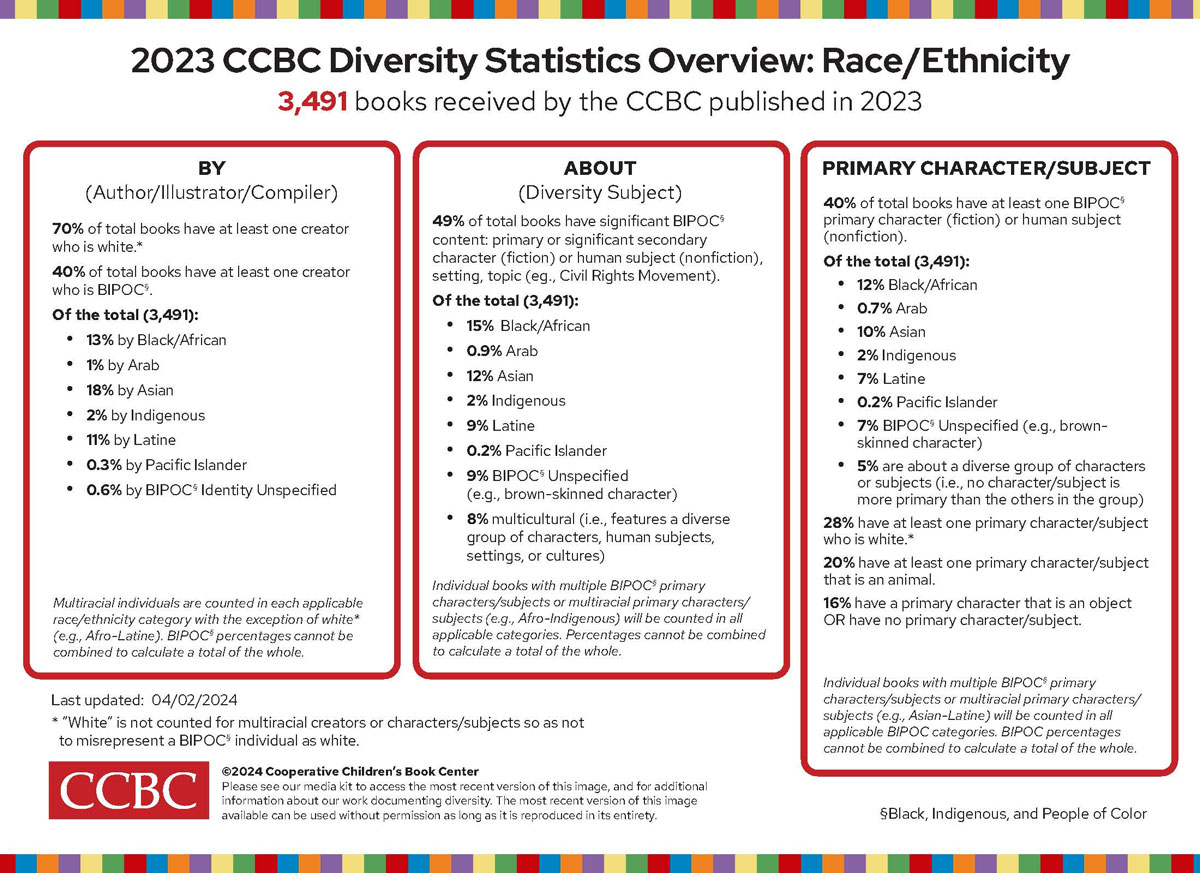BIPOC Representation in Children's Literatures Continues Its Slow Rise, According to CCBC's Diversity Statistics
The Cooperative Children’s Book Center released its latest Diversity Statistics report on children's literature, showing another year of small increases in books with BIPOC primary characters and significant BIPOC content.
The modest increases in diversity in children's literature continued in 2023, according to the latest Diversity Statistics report released by the Cooperative Children’s Book Center (CCBC).
In 2023, 49 percent of the books the CCBC documented had significant BIPOC content (up from 46 percent in 2022) and 40 percent had at least one BIPOC primary character (up from 39 percent in 2022). The number of books with at least one BIPOC creator was about the same as 2022. Those numbers continue the trend of slow growth in representation year to year. In 2022, the books with significant BIPOC content went up two percent (from 44 to 46) while BIPOC primary characters jumped three percent (from 36 to 39).
For this report, the CCBC analyzed 3,491 books for children and teens that were published in 2023.

Read the full press release below.
|
CCBC’s Diversity Statistics show small changes in number of diverse
books for children and teens published last year
The Cooperative Children’s Book Center (CCBC) has updated its annual Diversity Statistics to
include data on the 3,491 books for children and teens received by the CCBC that were
published in 2023.*
The CCBC has been documenting books for children and teens it receives annually by and
about Black, Indigenous, and people of color (BIPOC) since 1994. Between 1985 and 1993, the
CCBC documented books by and about Black people only.
In 2018, the CCBC began to document additional aspects of identity in its analysis, including
disability, LGBTQ+, and religion.
Following a long period of relative stagnancy, around 2015 the number of children’s books the
CCBC received by BIPOC creators and about BIPOC characters began to increase. By 2020 —
only five years later — the number of books the CCBC received that were by or about a person
of color had tripled.
While the statistics in 2022 showed a continuation of this rising trend, 2023 showed little
change. “We are glad things are not decreasing,” says CCBC Director Tessa Michaelson
Schmidt. “However, it’s disappointing there hasn’t been more movement in an upward direction.”
The CCBC did note a modest increase in the share of books including significant BIPOC
content in 2023 — meaning they have a primary or significant secondary character or human
subject who is BIPOC, or the setting or topic of the book relates to BIPOC people or history. In
2023, 49 percent of the books the CCBC documented had significant BIPOC content (up from
46 percent in 2022), and 40 percent had at least one BIPOC primary character (up from 39
percent in 2022).
On the other hand, the share of books having at least one creator (e.g., author, illustrator, or
compiler) who is BIPOC was nearly identical to 2022. Forty percent of the books the CCBC
received in 2023 were by a person of color. This includes 18 percent that had at least one Asian
creator, 13 percent that had at least one Black creator, and 11 percent that had at least one
Latine creator. By comparison, 70 percent of the books the CCBC received had at least one
white creator.
In recent years, the CCBC has seen more books that reflect the multifaceted complexity of
individual lives when it comes to identity — for example, books in which characters are
multiracial/multiethnic; that reveal intersectional identities; or that portray other dimensions of
identity, including disability, LGBTQ+, and minority (non-Christian) religions.
Of the books the CCBC received in 2023, 7 percent featured a primary or significant secondary
character/human subject with a disability or were about one or more disabilities, 7 percent
featured LGBTQ+ themes or characters, and 4 percent featured a minority religion.
The CCBC notes that books with multiple primary characters and/or subjects or primary
characters/subjects with multiracial or intersectional identities are counted in all applicable
categories. Percentages are not mutually exclusive and cannot be combined to calculate a total
of the whole.
As the number of books reflecting the lives and complex identities of children, teens, and
families today continues to grow, they are having greater visibility in libraries and classrooms,
and in the lives of children and teens.
“The CCBC Diversity Statistics focus on quantity, not quality. But what we know from our work
recommending books in our annual best-of-the-year list, CCBC Choices, is that greater numbers
inevitably mean more outstanding choices among the books published," says Schmidt.
"Librarians, teachers, parents, and other adults who care for children have more high-quality
books to choose from when selecting and recommending books for young readers and listeners
that reflect and validate dimensions of their identities and their place in our global society.”
The Cooperative Children’s Book Center (CCBC) is a unique examination, study, and research
library of the School of Education at the University of Wisconsin–Madison. The CCBC is also
funded by the Wisconsin Department of Public Instruction through the Division for Libraries and
Technology.
*The statistics about books by and/or about Black, Indigenous and people of color are
periodically updated online. This online data includes more detailed percentages, and the
number of books represented by each percentage.
|
RELATED
The job outlook in 2030: Librarians will be in demand
The job outlook in 2030: Librarians will be in demand
ALREADY A SUBSCRIBER? LOG IN
We are currently offering this content for free. Sign up now to activate your personal profile, where you can save articles for future viewing






Add Comment :-
Be the first reader to comment.
Comment Policy:
Comment should not be empty !!!